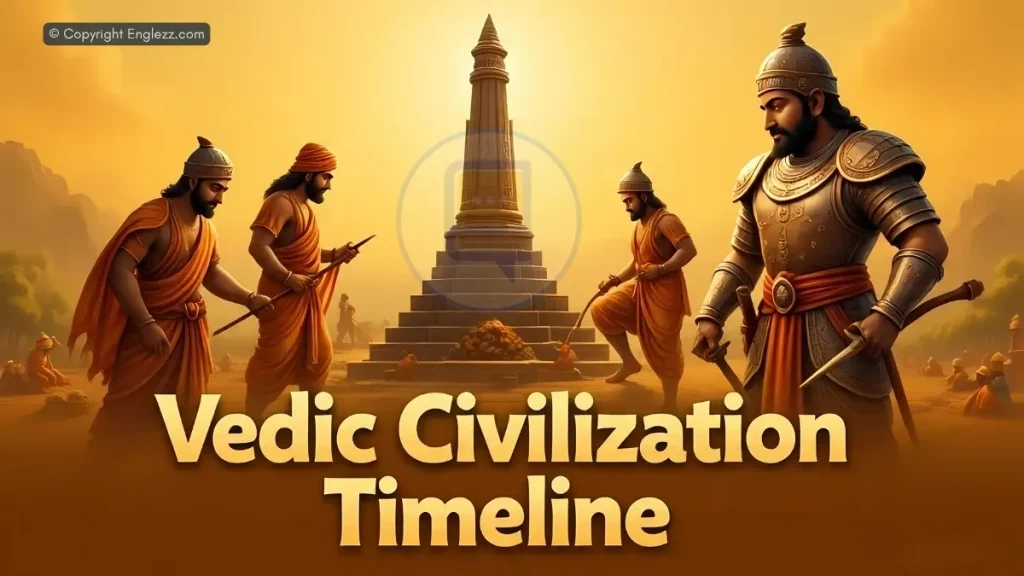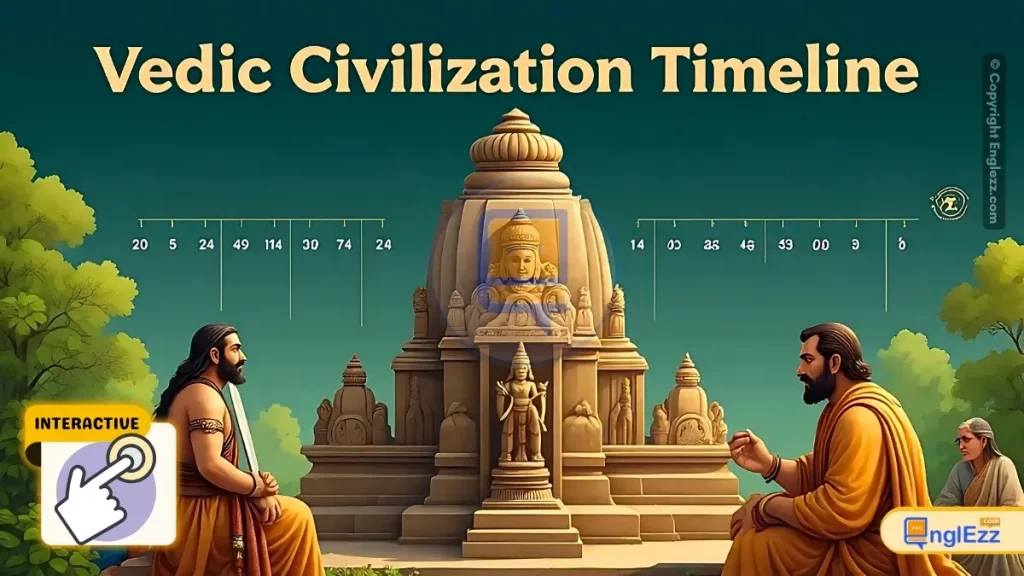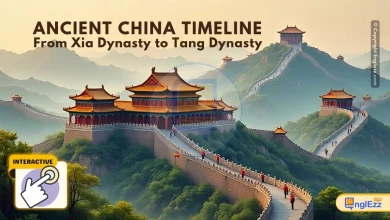
The Vedic Civilization
Foundations of Hinduism (1500-500 BCE)
Introduction
The Vedic Journey
The Vedic civilization was the foundation of Hindu culture in ancient India, flourishing between 1500-500 BCE. This period saw the composition of the Vedas, the oldest scriptures of Hinduism, and the development of key concepts like dharma, karma, and moksha. The civilization emerged in the northwestern regions of the Indian subcontinent, primarily along the Indus and Saraswati river valleys.
The Vedic people were initially pastoral nomads who gradually settled into agricultural communities. They developed a complex social structure that would evolve into the caste system, and their religious practices laid the groundwork for classical Hinduism. The Vedic period is divided into the Early Vedic (Rigvedic) period and the Later Vedic period, each with distinct characteristics in terms of society, economy, and religion.
Early Vedic Period
The Early Vedic period (1500-1000 BCE) was characterized by a pastoral, tribal society centered around the Rigveda. People lived in semi-nomadic communities, worshipped nature gods like Indra and Agni, and had a relatively egalitarian social structure. The primary political unit was the tribe (jana), led by a chieftain (rajan).
Later Vedic Period
The Later Vedic period (1000-500 BCE) saw the composition of the other Vedas (Sama, Yajur, Atharva) and the Upanishads. Society became more settled and agricultural, with the emergence of kingdoms and a more complex social hierarchy. The concepts of dharma (duty) and karma (action) became central to religious thought during this period.
Modern Understanding
Modern scholarship has revealed the profound influence of Vedic thought on Indian culture. The philosophical concepts developed during this period continue to shape Hinduism today. Archaeological discoveries and linguistic studies have helped reconstruct the migration patterns and daily life of the Vedic people, though many aspects remain debated among scholars.
Interactive Vedic Civilization Timeline
Composition of Rigveda
The earliest hymns of the Rigveda are composed, marking the beginning of Vedic literature and Hindu tradition.
Read moreThe Rigveda, the oldest of the four Vedas, was composed between 1500-1000 BCE by Indo-Aryan tribes migrating into the northwestern Indian subcontinent. It consists of 1,028 hymns (suktas) organized into ten books (mandalas), praising various deities like Indra (god of thunder), Agni (fire god), and Varuna (cosmic order).
Key features of the Rigveda:
- Oral composition and transmission by priestly families
- Focus on ritual sacrifice (yajna) to maintain cosmic order (rita)
- Reflection of a pastoral, semi-nomadic society
- Earliest expressions of concepts like rita (cosmic order) and satya (truth)
The Rigveda provides crucial insights into early Indo-Aryan society, religion, and their interaction with indigenous cultures. Its preservation through meticulous oral tradition is one of humanity’s great intellectual achievements.
Further Reading
- Jamison, Stephanie W., and Joel P. Brereton. The Rigveda: The Earliest Religious Poetry of India (2014)
- Witzel, Michael. The Origins of the World’s Mythologies (2012)
Migration into Ganges Plain
Vedic tribes begin migrating eastward into the Ganges river valley, adapting to new environments.
Read moreAround 1200 BCE, Vedic tribes began moving eastward from the Punjab region into the Gangetic plains, a process that would continue for several centuries. This migration was driven by:
- Population growth and search for new pastures
- Drying up of the Saraswati river (mentioned prominently in the Rigveda)
- Development of iron technology enabling forest clearance
The eastward expansion brought significant changes:
- Transition from pastoralism to settled agriculture
- Emergence of territorial kingdoms (janapadas) replacing tribal systems
- Interaction with indigenous cultures leading to cultural synthesis
- Development of more complex social hierarchies
This period saw the composition of later Vedic texts (Samaveda, Yajurveda, Atharvaveda) which reflect these societal changes.
Further Reading
- Erdosy, George. Urbanisation in Early Historic India (1988)
- Singh, Upinder. A History of Ancient and Early Medieval India (2008)
Later Vedic Texts Composed
The Samaveda, Yajurveda, and Atharvaveda are compiled, along with Brahmanas and early Upanishads.
Read moreThe Later Vedic period (1000-500 BCE) saw the composition of three additional Vedas and their associated texts:
- Samaveda: Musical arrangements of Rigvedic hymns for ritual chanting
- Yajurveda: Prose formulas for ritual procedures, divided into Black (Krishna) and White (Shukla) recensions
- Atharvaveda: Spells and charms for daily life, reflecting folk traditions
- Brahmanas: Detailed ritual commentaries explaining Vedic ceremonies
- Aranyakas/Upanishads: Philosophical texts exploring the nature of reality and the self (atman)
These texts reflect the evolution of Vedic thought from ritual sacrifice to philosophical speculation, particularly in the Upanishads which introduce concepts like:
- Brahman (ultimate reality)
- Atman (individual soul)
- Moksha (liberation from rebirth)
- Karma (law of cause and effect)
Further Reading
- Olivelle, Patrick. Upaniṣads: A New Translation (1996)
- Staal, Frits. Discovering the Vedas: Origins, Mantras, Rituals, Insights (2008)
Emergence of Janapadas
Vedic tribes establish territorial kingdoms (janapadas) along the Ganges plain, marking the transition from tribal to state society.
Read moreBy 800 BCE, the Vedic tribes had transformed from pastoral nomads into settled agricultural communities organized into territorial kingdoms called janapadas (“foothold of the people”). This political evolution was accompanied by:
- Development of iron technology enabling forest clearance and agriculture
- Emergence of towns as political and commercial centers
- Stratification of society into varnas (Brahmins, Kshatriyas, Vaishyas, Shudras)
- Growth of royal power and elaborate coronation rituals (rajasuya)
Sixteen major janapadas (mahajanapadas) emerged by 600 BCE, including powerful states like Magadha, Kosala, and Vatsa. These kingdoms would compete for supremacy in the subsequent period, leading to the rise of Magadha as the dominant power in northern India.
The Later Vedic texts reflect these changes, with increased emphasis on kingship, territorial control, and complex sacrificial rituals to legitimize royal power.
Further Reading
- Thapar, Romila. Early India: From the Origins to AD 1300 (2002)
- Allchin, F. R. The Archaeology of Early Historic South Asia (1995)
Rise of Heterodox Schools
New religious movements like Buddhism and Jainism emerge, challenging Vedic orthodoxy.
Read moreThe 6th century BCE saw the rise of alternative religious movements that challenged Vedic ritualism and Brahminical authority:
- Buddhism: Founded by Siddhartha Gautama (the Buddha), emphasizing the Four Noble Truths and Eightfold Path to end suffering
- Jainism: Founded by Mahavira, teaching strict asceticism and ahimsa (non-violence)
- Ajivikas: Fatalist school believing in predetermined destiny
- Charvaka: Materialist school rejecting supernatural concepts
These movements shared certain features:
- Rejection of Vedic authority and elaborate sacrifices
- Focus on individual spiritual development rather than birth status
- Use of vernacular languages rather than Sanskrit
- Appeal to urban merchants and artisans (vaishyas)
The challenge from these movements led to reforms within the Vedic tradition, including the systematization of philosophical schools (darshanas) and the composition of texts like the Bhagavad Gita that synthesized different approaches.
Further Reading
- Gombrich, Richard. What the Buddha Thought (2009)
- Dundas, Paul. The Jains (2002)
Compilation of Upanishads
The principal Upanishads are compiled, marking the philosophical culmination of Vedic thought.
The Upanishads (literally “sitting near a teacher”), composed between 800-500 BCE, represent the philosophical culmination of Vedic thought. The thirteen principal Upanishads include:
- Brihadaranyaka Upanishad
- Chandogya Upanishad
- Taittiriya Upanishad
- Katha Upanishad
- Isha Upanishad
Key philosophical concepts developed in the Upanishads:
- Brahman: The ultimate, formless reality underlying all existence
- Atman: The individual soul, identical with Brahman in essence
- Moksha: Liberation from the cycle of rebirth (samsara)
- Karma: The law of cause and effect governing rebirth
- Maya: The illusory nature of phenomenal reality
The Upanishads mark the transition from Vedic ritualism to classical Hindu philosophy, influencing all subsequent schools of Indian thought. Their teachings were systematized in the Vedanta school, particularly by Adi Shankara in the 8th century CE.
Further Reading
- Radhakrishnan, S. The Principal Upanishads (1953)
- Easwaran, Eknath. The Upanishads (1987)
Discovery of Indo-European Connection
Sir William Jones identifies Sanskrit’s relationship to European languages, founding comparative linguistics.
Read moreIn 1786, British philologist Sir William Jones, while serving as a judge in Calcutta, observed the striking similarities between Sanskrit, Latin, and Greek, proposing they shared a common ancestor. His famous statement:
“The Sanskrit language, whatever be its antiquity, is of a wonderful structure; more perfect than the Greek, more copious than the Latin, and more exquisitely refined than either, yet bearing to both of them a stronger affinity, both in the roots of verbs and in the forms of grammar, than could possibly have been produced by accident.”
This discovery led to:
- Development of comparative linguistics as a scientific discipline
- Reconstruction of Proto-Indo-European language and culture
- New understanding of ancient migrations and cultural exchanges
- Controversial “Aryan migration” theories about Vedic origins
Modern genetic studies have added complexity to these linguistic theories, showing multiple waves of migration into South Asia over millennia.
Further Reading
- Trautmann, Thomas R. Aryans and British India (1997)
- Mallory, J. P. In Search of the Indo-Europeans (1989)
Excavation of Indus Valley Sites
Archaeological discoveries at Mohenjo-Daro and Harappa reveal an earlier urban civilization predating the Vedic period.
Read moreThe discovery and excavation of Indus Valley Civilization sites (c. 2600-1900 BCE) in the 1920s by archaeologists like John Marshall, R.D. Banerji, and Daya Ram Sahni revolutionized understanding of South Asian prehistory:
- Revealed sophisticated urban planning with grid layouts and drainage systems
- Uncovered artifacts showing advanced craftsmanship and trade networks
- Discovered the still-undeciphered Indus script
- Showed evidence of ritual practices possibly ancestral to later Hinduism
These findings raised important questions about:
- The relationship between Indus people and Vedic Aryans
- Possible continuities in religious symbolism (e.g., proto-Shiva figures)
- Causes of the Indus civilization’s decline
- The origins of key Hindu concepts like yoga and ritual bathing
Ongoing excavations and genetic studies continue to shed light on this mysterious civilization and its connections to later Indian culture.
Further Reading
- Possehl, Gregory L. The Indus Civilization: A Contemporary Perspective (2002)
- McIntosh, Jane. The Ancient Indus Valley: New Perspectives (2008)
Vedic Civilization Quiz
Test Your Knowledge of Vedic History
Frequently Asked Questions
Common Questions About Vedic Civilization
While Vedic religion (1500-500 BCE) forms the foundation of Hinduism, there are significant differences:
- Deities: Vedic religion focused on nature gods like Indra and Agni, while Hinduism emphasizes the Trimurti (Brahma, Vishnu, Shiva) and goddess worship
- Rituals: Vedic practice centered around elaborate fire sacrifices (yajna), while Hindu worship (puja) involves offerings to deity images
- Philosophy: Early Vedic thought was ritualistic, while classical Hinduism developed complex philosophical systems
- Social structure: The varna system became more rigid over time into the caste system
The transition occurred gradually between 500 BCE-500 CE, with texts like the Mahabharata and Puranas bridging Vedic and classical Hindu traditions.
This remains a controversial question among scholars. The traditional “Aryan migration theory” suggests:
- Indo-Aryan speakers migrated into northwest India around 1500 BCE from Central Asia
- They brought with them Vedic religion and Sanskrit language
- This explains linguistic connections between Sanskrit and European languages
Alternative “Indigenous Aryanism” theories propose:
- Vedic culture developed indigenously in India
- The Saraswati river mentioned in the Rigveda corresponds to the Ghaggar-Hakra river system
- Archaeological evidence shows cultural continuity
Recent genetic studies suggest complex population movements with multiple waves of migration into South Asia over millennia.
The Vedic corpus consists of several layers of texts composed over centuries:
- Samhitas: The four Vedas (Rig, Sama, Yajur, Atharva) – collections of hymns and formulas
- Brahmanas: Ritual commentaries explaining sacrificial procedures
- Aranyakas: “Forest treatises” for hermits, transitional to Upanishads
- Upanishads: Philosophical texts exploring the nature of reality
- Vedangas: Auxiliary disciplines (phonetics, grammar, astronomy, etc.)
Later texts like the Mahabharata (containing the Bhagavad Gita) and Puranas, while not strictly Vedic, continue and develop Vedic themes.
Vedic civilization’s legacy remains profound in modern Indian culture:
- Religion: Hindu rituals, festivals, and concepts originate in Vedic traditions
- Language: Sanskrit remains the liturgical language and source of many Indian languages
- Philosophy: Concepts like karma, dharma, and moksha shape Indian worldviews
- Social structure: The varna system influenced caste organization
- Arts: Classical music, dance, and literature draw on Vedic heritage
Despite modernization, Vedic mantras continue to be recited in Hindu ceremonies, and the Vedas are revered as sacred scripture.
Conclusion
The Vedic Legacy
The Vedic civilization (1500-500 BCE) laid the spiritual, philosophical, and cultural foundations of Indian civilization. From the poetic hymns of the Rigveda to the profound speculations of the Upanishads, this period saw the development of concepts that would shape Hinduism and influence countless generations.
While the Vedic period ended over two millennia ago, its legacy continues to resonate in modern India and beyond. The philosophical questions raised in the Upanishads, the ritual practices codified in the Brahmanas, and the social structures outlined in later Vedic texts all contributed to the complex tapestry of Indian civilization.
Vedic Civilization Key Takeaways
Early Vedic Period
A semi-nomadic pastoral society centered around the Rigveda, with tribal organization and worship of nature deities like Indra and Agni.
Later Vedic Period
Transition to settled agriculture, emergence of kingdoms (janapadas), and composition of later Vedas and Brahmanas.
Upanishadic Age
Philosophical speculation on the nature of reality (Brahman), the self (atman), and liberation (moksha).
Social Structure
Development of the varna system (Brahmins, Kshatriyas, Vaishyas, Shudras) that would evolve into the caste system.
Modern Relevance
Vedic concepts continue to influence Hindu practice, while scholarly research sheds new light on this formative period.
The study of Vedic civilization reveals both the remarkable continuity of Indian culture and its capacity for transformation. As scholars continue to unravel the complexities of this ancient period through textual analysis, archaeology, and genetics, we gain deeper appreciation for how the Vedic world shaped not only India but the broader history of human thought.
Recommended Reading About Vedic Civilization
- Jamison, Stephanie W., and Joel P. Brereton. The Rigveda: The Earliest Religious Poetry of India (2014)
- Olivelle, Patrick. Upaniṣads: A New Translation (1996)
- Thapar, Romila. Early India: From the Origins to AD 1300 (2002)
- Singh, Upinder. A History of Ancient and Early Medieval India (2008)
- Staal, Frits. Discovering the Vedas: Origins, Mantras, Rituals, Insights (2008)









